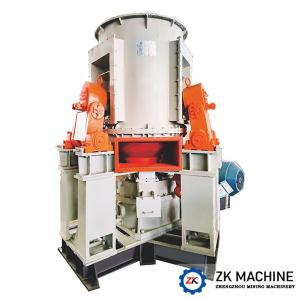
Add to Cart
Stable And Reliable Performance Vertical Raw Mill Easy And Safe To Operate
Vertical Raw Mill Introduction:
The vertical mill is mainly used for grinding raw meal, clinker, granular blast furnace slag, iron ore, limestone, coal powder, coke powder, coal gangue, fly ash, volcanic ash, gypsum, calcite, pyrophyllite, quartz, clay, sandstone, bauxite, silica fume, calcined rice shell and other processing industry related to metal and non-metal mine.

Comparison Between Ball Mill and Vertical Mill:
The working principles of the two are different. The grinding principle of the ball mill is to pulverize the large-particle materials into small-particle materials through the impact between the large steel balls, and then grind the small-particle materials through the relative movement between the small balls.To achieve the purpose of grinding, the sphericity of the powder produced by the ball mill is better, and the surface is relatively smooth. The working principle of the vertical mill is to directly crush and grind large particles of materials into fine powder by the squeezing and shearing between the grinding roller and the grinding disc. The powder produced by the vertical mill is in the form of flakes under the microscope and has a relatively round sphericity difference.

Vertical Raw Mill Working Principle:
The raw material from dosing station after weighing, transported into inlet of vertical mill by belt conveyor, then fed into rotary air lock of vertical mill with outer recycle materials, after the grinding, drying, separating, the crude material comes back grinding disc for grinding again, the qualified product will be brought into cyclone filter through separator, the product collected by cyclone filter and powder from bag filter at the kiln tail comes into raw meal homogenizing silo by air chute, bucket elevator and so on.

| specification | capacity (t/h) |
speed (r/min)
| Grinding media (t) | motor | reducer | weight(t) | ||
| model | power (kW) | model | speed ratio | |||||
| Φ1.2×4.5 | 1.7 | 30.3 | 5 | YR250M-6 | 55 | ZD30-8 | 4.481 | 13.1 |
| Φ1.5×5.7 | 4.5 | 26.34 | 11 | JR127-8 | 130 | ZD40-7 | 4 | 25 |
| Φ1.83×7 | 11 | 24.5 | 20 | JR138-8 | 245 | ZD60-8 | 4.5 | 37.2 |
| Φ2.2×7.5 | 16-22 | 21.4 | 32 | JR158-8 | 380 | ZD70-9 | 5 | 53.6 |
| Φ2.4×13 | 35-38 | 19.4 | 69 | YR800-8 | 800 | JDX800/MBY800 | 6.33 | 78 |
| Φ2.6×13 | 50-55 | 19.5 | 83 | YR1000-8/1180 | 1000 | JDX800/MBY800 | 4.5 | |
| Φ2.8×10 | 40-48 | 19.7 | 70 | YR800-8/1180 | 800 | D110A | 37.5 | |
| Φ3.0×12 | 55-58 | 18 | 100 | YR1250-8/1430 | 1250 | JS110-A | 41.1 | |
| Φ3.2×10 | 55 | 17.6 | 98 | YR1000-8/1180 | 1000 | JS110 | 41.5 | |
| Φ3.5×10 | 73 | 16.8 | 118 | YR1250-8 | 1250 | JS110-A | 153.7(without motor) | |
| Model | Grinding plate(mm) | output(t/h) | output(×10kt/a) | Main motor power(kW) | |||||
| diameter | Pitch | blast furnace slag | cement | Raw meal | blast furnace slag | cement | Raw meal | ||
| ZKRM08.2 | 1200 | 800 | 1.5~2 | 3~4 | 6~8 | 1.5 | 3 | 5.5 | 55 |
| ZKRM11.2 | 1500 | 1100 | 3~4 | 5~6 | 10~12 | 3 | 4.5 | 9 | 110 |
| ZKRM13.2 | 1700 | 1300 | 8~9 | 11~13 | 20~22 | 6 | 9.5 | 17 | 185 |
| ZKRM15.2 | 1900 | 1500 | 9~10 | 14~16 | 26~34 | 8 | 12 | 24 | 250 |
| ZKRM17.2 | 2100 | 1700 | 12~14 | 20~23 | 40~50 | 10 | 17 | 36 | 355 |
| ZKRM19.2 | 2300 | 1900 | 15~17 | 24~26 | 50~60 | 13 | 20 | 43.5 | 450 |
| ZKRM20.2 | 2400 | 2000 | 18~20 | 27~30 | 60~75 | 15 | 22.5 | 55 | 560 |
| ZKRM22.3 | 2600 | 2200 | 23~25 | 40~50 | 85~110 | 20 | 35.5 | 77 | 710 |
Remarks: the basic standard for vertical mill is as follow:
(1)Power consumption:slag≤25kWh/t,cement≤18kWh/t,raw meal≤9kWh/t;
(2)Moisture content:slag≤15%,cement≤3%,raw meal≤7%;
(3)Ffinished product fineness: specific surface area of slag 4200~4500cm²/g,specific surface area of cement 3300~380 cm²/g,raw meal fineness-80μmR 12~15%;
(4)Moisture content of refined powder:slag 0.5~1.0%,cement 0.5~1.0%,raw meal 0.5~1.0%;
(5)The specific installed capacity and parameters can be adjusted properly according to actual material nature.
(6)The above parameters are applicable for granular blast furnace slag, cement and raw meal and the model selection is determined by material property.